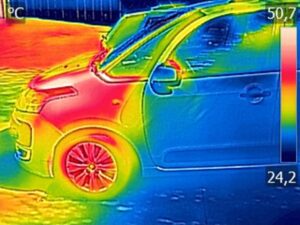LWIR Imaging (Long-Wave Infrared Imaging) Becomes More Accessible

LWIR imaging
In our modern world, LWIR Imaging – new technologies seem to be introduced on the market with lightning speed. The advancements are endless. The launch of new products based on emerging technology is constant. Long-wave infrared imaging – LWIR Imaging, or thermal imaging – is one such technological advancement.
It’s not quite x-ray, but it’s as close as you can get. LWIR imaging has become more affordable for industrial markets due to recent advances in detector fabrication.
The first infrared cameras were introduced during the first half century of the 20th Century. Three generations of infrared camera have been produced since its introduction. The first generation cameras had a single element sensor, which was combined with two scanning lenses to produce infrared pictures. The main problem with these cameras was saturation. The second generation cameras are characterized by a larger number of detectors arranged in either a linear array or two 2-D arrays.
Third-generation cameras are currently used and have improved the reliability and sensitivity infrared system. Modern cameras have a higher number of pixels and a greater thermal sensitivity. They also have boosted acquisition frequencies.
LWIR imaging detectors are not sensitive to scattered or reflected light. They respond primarily to the infrared energy emitted by objects. This deep infrared is best experienced with outdoor heaters that are found on terraces, or red heat lamps in restaurants. They emit a high amount of infrared light to heat the skin or food.
A LWIR imaging sensor will indicate the location and quantity of heat radiation. This has two distinct benefits: the scene is independent of lighting conditions, and the sensor can identify any heat-generating object. LWIR technology has been a key enabling technology in modern warfare for many years because of this last advantage.
LWIR imaging with radiometric applications can be an asset to industries like food and material processing, as it allows for the measurement of temperature at random places, without any physical contact. This provides a greater level of coverage for process control and yield reduction. For example, a chicken nugget plant might want to verify the temperature of each product when it comes out of the oven. All that’s needed for accurate measurements with a calibrated camera is inputting information about the surface finish of the target object (emissivity), and the ambient conditions.
LWIR imaging has also been used in the automotive industry. BMW, a major automaker in the world decided to install a thermal imaging system for enhanced driver vision into its top-of the-line 7 series. BMW prioritizes increasing passenger and driver security. BMW wanted to find a way to reduce the number of accidents that occur during nighttime driving.
Ford Motor Company engineers use thermal imaging to identify where air is escaping from vehicles. Ford Motor Company can test different ways to contain air in a vehicle using LWIR imaging. It is useful for the development of new vehicles, as it helps to reduce air leaks and noise.
Thermal imaging will play a larger role in automation, medical inspection and other fields that require heat measurement in the future.
SUPERIOR® Optics can design and manufacture the perfect lens for your camera system that incorporates LWIR.



